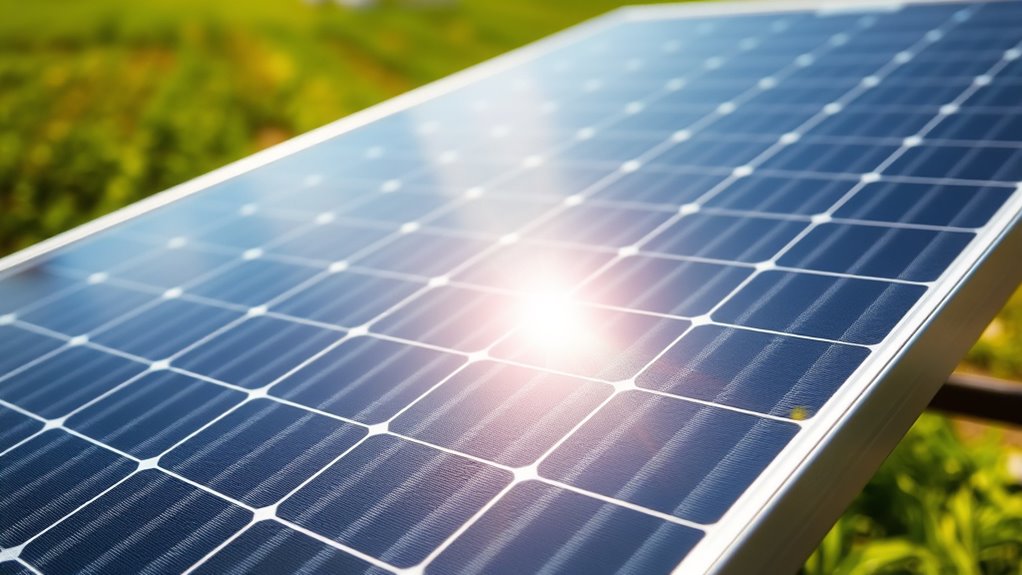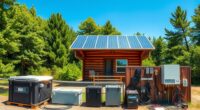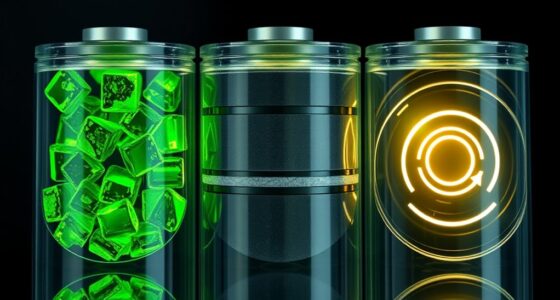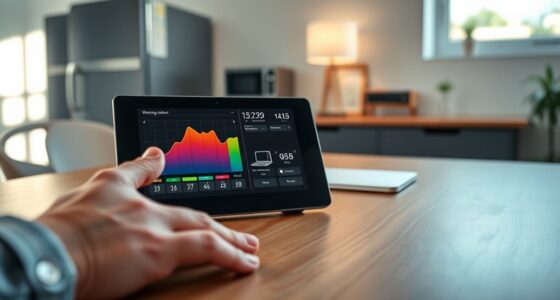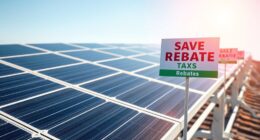A 100W solar panel‘s actual output depends on sunlight, efficiency, and conditions, so it won’t always produce exactly 100 watts. Factors like temperature and shading can lower its performance, meaning you may get less power than rated. Higher efficiency panels convert sunlight more effectively, maximizing your energy even in limited space. To understand what a 100W panel truly delivers and how it fits your needs, it’s helpful to explore the details further.
Key Takeaways
- A 100W solar panel can produce up to 100 watts under ideal sunlight conditions, but actual energy depends on factors like sunlight intensity and efficiency.
- Real-world energy output is often less than the rated wattage due to inefficiencies, weather, and installation angles.
- Higher efficiency panels convert sunlight more effectively, meaning a 100W panel with better efficiency can generate more usable energy.
- The physical size of a 100W panel varies; more efficient panels may be smaller, optimizing space in limited areas.
- Understanding wattage alone isn’t enough; consider efficiency and conditions to accurately estimate what a 100W panel will deliver over time.
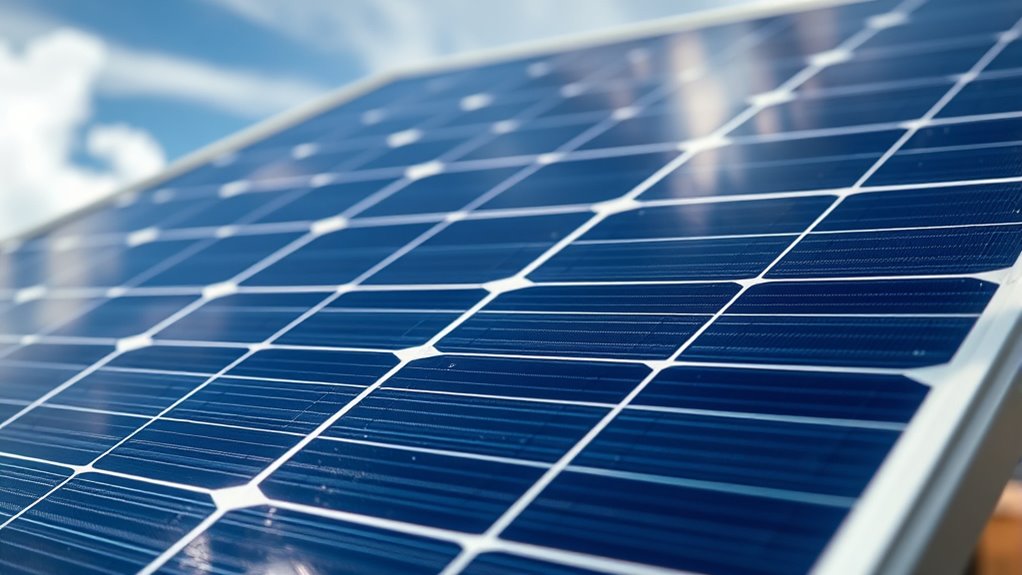
Have you ever wondered how solar panel wattage affects your energy production? Understanding this can help you make smarter decisions when choosing a system for your home or business. The wattage rating, like 100W, indicates the panel’s maximum power output under ideal conditions. But that number alone doesn’t tell the full story. Solar panel efficiency plays a significant role in how much energy you’ll actually get from a panel of a certain wattage. A highly efficient 100W panel captures more sunlight and converts it into electricity more effectively than a less efficient one. This means that, even with the same wattage rating, two panels might perform quite differently depending on their efficiency ratings. So, when considering different panels, look beyond the wattage and pay attention to their efficiency specs to gauge their real-world performance.
It’s also important to recognize that higher wattage panels typically cost more upfront, which influences your overall installation costs. While a 100W panel might seem affordable, it may require multiple panels to meet your energy needs, increasing both the initial investment and installation complexity. Conversely, a higher wattage panel, like a 300W or 400W unit, can generate more power with fewer panels, potentially reducing installation costs over time. However, higher wattage panels are often more expensive per panel, so there’s a balance to strike between upfront costs and long-term energy savings. When planning your system, consider not just the initial price but also how efficiency and wattage work together to impact your total costs and energy output.
In addition to efficiency and costs, the physical size of the panel matters. A panel with higher wattage and efficiency might be larger or more compact depending on its design, affecting the installation process. If space is limited, choosing a more efficient, higher wattage panel can maximize your available area. But if you’re working within a tight budget, starting with lower wattage panels and expanding later might make more sense financially. Remember, the key is to match the panel’s wattage and efficiency with your energy goals and budget. Doing so ensures you get the most value from your investment, balancing upfront costs with long-term savings.
Ultimately, understanding how wattage influences your energy production means looking at the big picture. It’s not just about the number on the panel but how efficiently it converts sunlight into usable electricity and how much that costs you initially. By considering both solar panel efficiency and installation costs, you can design a system that meets your needs without overspending or underperforming. Additionally, understanding the efficiency ratings of panels can help you select options that deliver optimal performance within your space constraints.
Frequently Asked Questions
How Does Temperature Affect a 100W Solar Panel’S Output?
You should know that temperature effect impacts your 100W solar panel’s output by causing efficiency reduction. When temperatures rise, the panel’s ability to convert sunlight into electricity drops because the solar cells become less efficient. Conversely, cooler temperatures help maintain ideal performance. So, hot days can decrease your panel’s power, while cooler conditions allow it to produce closer to its rated wattage, maximizing your solar energy generation.
Can Multiple 100W Panels Increase Total Power?
Imagine stacking your favorite records—multiple 100W panels work the same way. Connecting them in a panel configuration boosts your total power output, as long as you optimize efficiency. Series connections increase voltage, while parallel setups boost current, helping you tailor your system. Using the right configuration guarantees you maximize energy harvest, turning a few panels into a powerful solar array. So yes, multiple panels definitely increase your total power.
What Is the Lifespan of a Typical 100W Solar Panel?
A typical 100W solar panel lasts about 25-30 years, but panel degradation gradually reduces its efficiency over time. You should expect about a 0.5% annual decline, which means less power output as years go by. Regular maintenance helps minimize maintenance costs and keeps it functioning well. Proper care prolongs its lifespan, ensuring you get the most out of your investment before replacement becomes necessary.
How Do Shading Issues Impact a 100W Panel’S Performance?
Did you know that shading can reduce a solar panel’s efficiency by up to 80%? When shadows fall on your 100W panel, shadow loss occurs, substantially impacting its performance. Even a small shadow from leaves or debris can cause a big drop in output. To maximize your panel’s efficiency, keep it clear of shading as much as possible, ensuring ideal sunlight exposure and energy production.
Is a 100W Panel Suitable for Off-Grid Applications?
A 100W panel can work for off-grid applications if your energy needs are modest. You’ll need a battery with enough capacity to store the generated power and guarantee your devices stay running. Make sure your inverter is compatible with the panel’s output and your battery system. This setup suits small cabins or camping setups, but for larger needs, consider higher wattage panels for reliable, sustained power.
Conclusion
Now that you understand what 100W really delivers, you can better gauge your solar panel‘s potential. Think of wattage as the engine’s horsepower—powering your energy needs with precision. Remember, higher wattage isn’t always better if your goals don’t require it. By grasping these nuances, you’re steering your solar journey with confidence, steering your energy future as surely as a captain navigates through calm and stormy seas alike.
